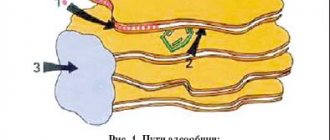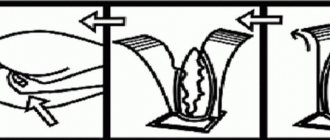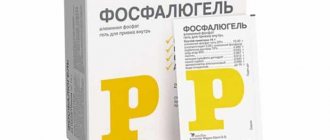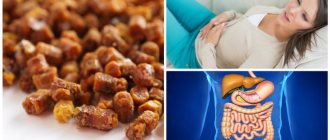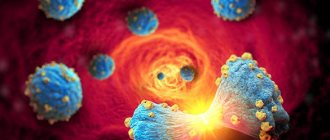Instructions for use
If suspicious symptoms appear, you should consult a doctor as soon as possible to make a diagnosis and choose the preferred treatment regimen. Typically, therapy includes taking drugs with antibacterial, antifungal and antiprotozoal effects. One of these drugs is Intetrix.
pharmachologic effect
Intetrix is a broad-spectrum intestinal antiseptic. Doctors believe that the drug is most effective against vegetative types of amebiasis, since the drug has powerful antimicrobial, bactericidal and bacteriostatic abilities.
Intetrix stops the negative effects of the yeast-like fungus C. albicans and microorganisms such as S. Faecalis, Pseudomonas aeruginosa, Proteus vulgaris, Serratia marcescens, Vibrio cholerae Inaba, Vibrio cholerae Ogava, etc. The structure of Intetrix does not contain chlorine or iodine ions, which cannot be said about other hydroxy-8-quinoline derivatives. The drug does not upset the balance of normal intestinal microflora.
In chronic amebiasis, the pharmacological effect is achieved due to the synergism of the amoebicidal action of the three antiseptic components included in the drug. Intetrix acts in the intestinal lumen and is prescribed to people suffering from intestinal amebiasis.
3-4 hours after taking the capsules, the maximum concentration of the drug in plasma is observed. The half-life is approximately 10 hours. After 12-24 hours, the maximum excretion is determined. Intetrix is completely eliminated after two days.
When administered orally, the degree of absorption of the drug in the gastrointestinal tract is not high. This allows you to maintain effective con
Intetrix is metabolized in three ways:
- entry into the blood following absorption from the intestine;
- partial absorption, transformation in the intestine, excretion;
- entry without absorption into the intestine, excretion with intestinal contents.
Indications for use
Intetrix is used to treat intestinal amoebiasis in adult patients:
- monotherapy for asymptomatic cases of diagnosed amoebiasis;
- complex therapy, including the use of tissue amoebicides.
Sometimes the drug is prescribed for the preventive treatment of intestinal infections, for example, dysbiosis or diarrhea.
Mode of application
Intetrix is suitable for oral use. The treatment regimen depends on the diagnosis:
| Diagnosis | Treatment regimen |
| Acute severe intestinal infections | 6-8 capsules of the drug per day; frequency of administration – from 3 to 4 times a day. |
| Moderate course of the disease | 4-6 capsules per day for three to five days. |
| Chronic amoebiasis | 4 capsules per day for 10 days; a second course of treatment is carried out after a month. |
| Prevention of mycoses when using broad-spectrum antibiotics, as well as diarrhea caused by fungi | 3 capsules of Intetrix per day. |
| Prevention of intestinal infections (necessary for visitors to endemic regions) | 2 capsules of the drug per day for the duration of your stay in such regions. |
The medicine is taken before meals with a small amount of water. To make it easier to take the drug (for example, when treating children), the capsule can be opened and its contents added to 1 tsp. food.
Release form, composition
Intetrix is available in the form of opaque capsules of size No. 1 with a white body and a dark red cap. The capsule contains a grayish-yellow microcrystalline powder. The drug is sold in blisters placed in cardboard packaging.
The drug contains three active components: tiliquinol, tilbroquinol and tiliquinol N-dodecyl sulfate. Excipients (inactive) ingredients include corn starch and lactose monohydrate.
The body and cap of the capsule contain components such as indigotine, titanium dioxide, azorubine and gelatin. The weight of the capsule contents is 420 mg.
Interaction with other drugs
Intetrix is not recommended to be taken in combination with medications that contain hydroxyquinolines.
Intetrix®
Manufacturer: BEAUFOUR IPSEN INTERNATIONAL (France)
◊ capsule: 10 or 20 pcs. Reg. No.: P No. 011534/01
Clinical and pharmacological group:
A drug with antibacterial, antiprotozoal and antifungal effects, a derivative of 8-hydroxyquinoline. Antidiarrheal drug
Release form, composition and packaging
◊ Capsules
size No. 1, with an opaque dark red cap and an opaque white body; the contents of the capsules are microcrystalline powder of grayish-yellow color.
| 1 caps. | |
| tiliquinol | 50 mg |
| tiliquinol lauryl sulfate | 50 mg |
| tilbroquinol | 200 mg |
total content of tiliquinol in 1 caps. ranges from 65.2 mg to 72.2 mg (theoretical 68.7 mg ± 5%). N-dodecyl sulfate = lauryl sulfate.
10 pieces. - blisters (1) - cardboard packs. 10 pieces. - blisters (2) - cardboard packs. 20 pcs. - blisters (1) - cardboard packs. 20 pcs. - blisters (2) - cardboard packs.
Description of the active components of the drug "Intetrix®"
pharmachologic effect
The pharmacological effect in chronic amebiasis is achieved due to the synergism of the amoebicidal action of the three antimicrobial components that make up Intetrix.
The drug acts in the intestinal lumen and is used to treat intestinal amebiasis.
Intetrix® is effective against vegetative forms of amoebiasis. Intetrix® does not disturb the balance of normal intestinal microflora.
Indications
Intestinal amoebiasis in adults:
— as part of complex therapy with tissue amoebicides;
- monotherapy for asymptomatic cases of diagnosed amoebiasis.
Dosage regimen
Prescribe 2 caps. in the morning and 2 caps. in the evening for 10 days.
Capsules are taken orally, whole, preferably at the beginning of a meal, with a sufficient amount of water.
Side effect
Rarely
Skin reactions
such as urticaria, angioedema and persistent pigmented erythema may occur
Extremely rare, in cases of long-term use
peripheral neuropathy and transient optic nerve disorders may occur.
Rarely
When taking the drug, an increase in transaminase levels is possible.
Contraindications
- individual hypersensitivity to the components of the drug.
Carefully :
liver failure.
Pregnancy and lactation
In animal studies, no terratogenic effect was detected. Currently, there is not enough data to assess the potential risk of birth defects or the fetotoxic effect of the drug when administered during pregnancy. Studies of the effect of the drug on lactation in animals have not been conducted.
Therefore, the use of Intetrix during pregnancy and breastfeeding is undesirable. In the presence of recurrent miscarriages, the use of the drug is not recommended, since this condition requires careful monitoring and well-planned prenatal monitoring.
Use for liver dysfunction
With caution: liver failure.
special instructions
If the level of transaminases increases, especially in liver failure, it is necessary to stop treatment with the drug.
Long-term use of Intetrix is not advisable due to the risk of peripheral neuropathy.
Overdose
In case of overdose, it is necessary to monitor the activity of serum transaminases, as well as the level of prothrombin.
Drug interactions
The drug should not be prescribed simultaneously with medications containing hydroxyquinolines.
Conditions for dispensing from pharmacies
The drug is approved for use as a means of OTC.
Storage conditions and periods
Store at a temperature not exceeding 25°C out of the reach of children. Shelf life: 3 years.
Drug interactions
The drug should not be prescribed simultaneously with medications containing hydroxyquinolines.
Side effects
In isolated cases, an increase in the level of liver transaminases was noted; this was usually asymptomatic and resulted in a decrease in transaminase levels after the end of therapy.
Some doctors have reported the development of hepatitis and rare skin reactions of the bullous (erythema persistent pigmentosa) or hypersensitive (Quincke's edema, urticaria) type. Long-term use of the drug led to damage to the optic nerve and the development of peripheral neuropathy, but this happened extremely rarely.
More common side effects include nausea and gastralgia (cramping pain in the stomach area).
Overdose
In case of overdose, the level of prothrombin and the activity of serum transaminases should be monitored.
Contraindications
It is forbidden to take Intetrix:
- children under 14 years of age;
- in the presence of individual hypersensitivity to the substances contained in the drug.
Medicines are prescribed with caution to patients suffering from liver failure.
During pregnancy
To date, there is not enough information to assess the potential fetotoxic or malformative effects of this drug when used during pregnancy.
Doctors prohibit both lactating and pregnant patients from taking Intetrix.
Women of reproductive age taking Intetrix should choose reliable methods of contraception to prevent pregnancy.
Use of Intetrix in the treatment of intestinal dysbiosis in young children
Home Articles Professional publications of doctors Gastroenterology
Over the past 8-10 years, the problem of studying dysbacteriosis in young children has intensified significantly. Many factors have been described that contribute to the formation of the inflammatory process in various parts of the digestive system.
A common link in the complex pathogenesis of intestinal diseases is an imbalance of intestinal microflora, which in some patients may be a consequence of the disease, in others - a triggering etiopathogenetic mechanism. In recent years, a large role in the development of chronic intestinal diseases has been given to conditionally pathogenic microorganisms such as Protea, Klebsiella, Citrobacter, hemolyzing Escherichia coli, fungi of the genus Candida and hemolyzing Staphylococcus.
Considering the low therapeutic effect of drugs used to treat dysbiosis in young children, we have been using the drug Intetrix for 5 years. This drug is prescribed to children in an age-appropriate dose in the subcompensated and decompensated phase of intestinal dysbiosis.
Intetrix is an intestinal antiseptic, synthesized in accordance with Good Manufacturing practice standards in the BOFUR research laboratory in DREU, France. Compound:
- Tiliquinol 50 mg.
- Tiliquinol N-Dodecyl sulfate 50 mg.
- Tilbroquinol 200 mg.
These components of the drug have synergism with each other, the bactericidal spectrum of action of which complements each other, potentiating the effect of each of them.
The presence of methyl groups and the absence of chlorine and iodine halogens in the molecular structure of the drug, unlike other hydroxyquinolines such as enteroseptol, intestopan, ensures Intetrix safety of use. Antimicrobial activity: Wide antimicrobial spectrum of action (gram-positive and gram-negative bacteria), antifungal effect, antiamoebic effect.
Unlike many antiseptics, Intetrix maintains the balance of saprophytic flora. Numerous clinical studies by the company have shown that Intetrix in therapeutic doses does not change the normal composition of the intestinal microflora. In addition, by acting on pathogenic bacteria, intetrix protects the physiological activity of saprophytic flora. This phenomenon is explained by the specificity of the antigenic structure of pathogenic microorganisms, which are very sensitive to it. Representatives of the saprophytic flora have a different antigenic structure, which provides them with greater resistance.
The purpose of this work was to study the clinical and laboratory indicators of intestinal dysbiosis before and after the use of the drug Intetrix. For the study, we took four groups of children aged 0 to 2 years:
- the group received hilak forte
- furazolidone
- Linux
- intetrix
The studies were carried out in the acute period of the disease. The drugs were dosed according to the age and recommendations of the manufacturers. Intetrix was prescribed at a dose of 10 mg. For 1 kg. mass per day, for 5-8 days, depending on the severity of the clinical manifestations of the disease.
- 0-3 months 1/6 cap. x 1 time per day
- 4-5 months 1/5 drop x 1 time per day
- 6-9 months 1/4 drop x 1 time per day
- 10-12 months 1/4 drop x 2 times a day
- 1 - 1.5 years 1/5 drop. x 3 times a day
- 2 years 1/4 cap. x 3 times a day
In total, over the years we have treated 826 people aged 0-2 years. All children who received the drug were observed by us for 6-15 months. Particular attention was paid to the dynamics of regression of clinical symptoms and changes in the coprogram and the composition of the intestinal microflora. The research results are presented in tables No. 1 and No. 2. By clinical effect we mean normalization of appetite, disappearance of dyspeptic symptoms, weight gain, normalization of temperature.
In stool tests for dysbacteriosis, microbes predominated: St/ Aureus - 67.4%, hemolyzing Escherichia - 24.1%, fungi of the genus Candida - 4.3%, Proteus - 4.1%, others - 0.1%.
Clinical effect of therapy as a percentage by day.
Table No. 1
| Drugs | Observation days | |||||||||||
| 2 | 3 | 4 | 5 | 6 | 7 | 8 | 9 | 10 | 11 | 12 | 20 | |
| Hilak-forte | 74,3 | |||||||||||
| Furazolidone | 68,4 | 74,6 | ||||||||||
| Linex | 47,3 | 63,2 | ||||||||||
| Intetrix | 76,3 | 91,7 | ||||||||||
Dynamics of restoration of intestinal flora in percentage by day.
Table No. 2
| Drugs | Observation days | |||||||||
| 10 | 20 | 30 | 40 | 50 | 60 | 70 | 80 | 90 | ||
| Hilak-forte | 53,7 | 64,3 | ||||||||
| Furazolidone | 69,1 | 43,8 | ||||||||
| Linex | 43,7 | 57,2 | Intetrix | 88,3 | 96,1 | |||||
The results obtained indicate the good effectiveness of Intetrix in the treatment of dysbiosis in children aged 0-2 years.
In children, from the first day of treatment, we noted a pronounced effect and good tolerability of the drug. In 3 children (0.4%) with intestinal dysbiosis complicated by atopic dermatitis, we noted a deterioration in the skin, which forced us to add short-course desensitizing drugs to the complex treatment. Biochemical blood monitoring (FPP-selective), after drug therapy, did not reveal any changes; no enlargement of the liver was noted in children. The study noted the fact that the drug is highly effective in the treatment of dysbiosis caused by Proteus and fungal flora, when other antiseptics were ineffective.
Thus, our observations make it possible to recommend the use of the drug Intetrix for children aged 0-2 years with intestinal dysbiosis in the stage of subcompensation and decompensation.
Authors: Zemlyakov V.L., Ph.D., Honored Doctor of the Russian Federation Saevets N.V.
Source : Medical Pediatric Center Dulkina L.A. print version
Reviews
Most reviews about the drug are positive.
People who have used this remedy note that it copes well not only with amebiasis, but also with those intestinal infections that cause diarrhea.
Read consumer reviews of Intetrix at the end of the article. If you have had experience using this drug, please tell us about it. This will help other Internet users obtain complete information about the drug.
